The U.S. M1 Carbine was first introduced in 1941, mostly as a response to the Blitzkreig tactics successfully employed by the Germans in 1939-1940. With the advent of rapidly moving mechanized columns and vertical envelopment by airborne troops it became apparent that rear echelon troops, previously considered essentially non-combatant, could now become engaged by hostile forces. It was clear that there was a need for a weapon other than the traditional side arm for these personnel. Intended to replace the pistol for officers, Signal Corps troops, and crew served weapons teams, the M1 Carbine was designed as a light-weight rifle so these personnel could perform their duties without the hindrance of bulky weapons. A variation designated the M1A1 with a folding metal buttstock was adopted in May of 1942 to meet the needs of the U.S. Airborne troops.
This diminutive .30 caliber, 15-round, semi-automatic carbine saw widespread use far exceeding its original intended purpose, with over 6 million made by the end of the war. It was liked for its small size and weight, large capacity detachable magazine and high rate of fire. It was disliked for its lack of stopping power, inaccurate sights, push button safety and easily bendable barrel. The magazine release was often mistaken for the push button safety causing the magazine to fall out at rather inopportune times with possible fatal results!
After the invasions of North Africa and Italy enough M1 Carbines had made their way into German hands that they had an official Wehrmacht designation of SKb 455(a). SKb was the abbreviation for Selbsladekarabiner translating to: self-loading carbine the “a” standing for amerikanisch. The compact M1 Carbine was also air dropped in fair numbers to French resistance fighters and even smuggled in to Yugoslavian “partisans”.

Until the availability of Swanson Motion Picture Blanks for the .30 caliber carbine the M1 was not really an appropriate weapon for reenacting use. The military surplus training blanks for the carbine seldom produced enough flash or noise to let anyone know they had been “shot”, in fact one could hear little more than the action cycling! Swanson blanks are remanufactured from .223 cases. Not only do they have to be formed and resized but each case head has to be turned on a lathe to the proper base and rim dimensions. These little .30 caliber blanks cost about a dime more than the standard caliber blanks Joe Swanson offers, but the noise and flash is so awesome (making the little carbine a real “power house” to shoot), they are well worth the price.
Unlike the M1 Garand the M1 Carbine has no provision for a screw on blank adapter, and as the military blank firing devices that lock over the front sight are unacceptable for reenacting, the only choice is to thread the inside of the barrel for the adapter. Because this pretty much ruins any collector value the weapon may have, it is best to start with a good “shooter” grade carbine. These used to be available at most gun or pawn shops in the $200 or less price range, but now it seems that it is difficult to find any M1 Carbine for less than $300. The majority of these post-war configuration guns come with a “pot belly” stock, an adjustable rear sight, bayonet lug, lever safety and four rivet front hand-guard. With enough money and time one could “restore” a post-war gun to original war-time configuration but this article will only deal with blank adapting and giving it the “look” of a WWII issue carbine at minimal cost.
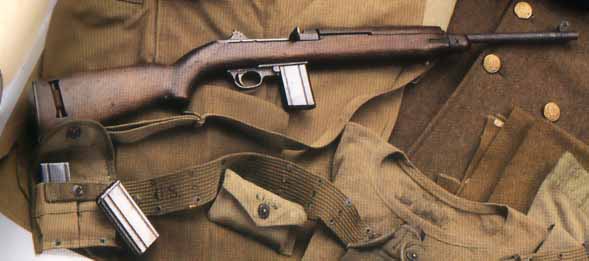
After you have purchased a gun, take it to the range and make sure it works with live ammo. If it has functioning problems with the real thing and you don’t know it, trying to get it to work with blanks will drive you crazy! Check that the slide spring is strong enough to easily strip off and chamber the top cartridge of a full 15 round magazine. A replacement spring, reproduction “L” rear sight and an early style barrel band are available from Numrich Gun Parts for less than $50 for all three, including shipping. Try to find and use surplus “new in wrap” 15 round magazines. Strong mag springs are a must because of the faster than normal cycle rate usually encountered with blanks.
The technique for blank adapting the M1 carbine is really very simple, no alterations to the gun are needed other than installing the proper size gas restrictor in the barrel. However, you will need to know how to disassemble and reassemble the weapon and have access and familiarity with the tools mentioned. Even so, some of the methods I will describe should only be attempted by a gunsmith or qualified machinist with the proper skills and equipment.
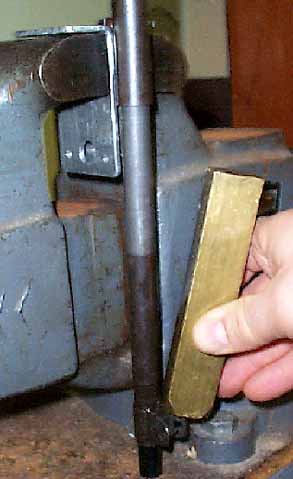
First remove the stock and strip the gun of the trigger assembly, slide, and bolt. Next use a small punch to knock out the front sight pin. To get the bayonet band off you have to remove the front sight. This really is one of the hardest parts of the whole project as some sights can be very stubborn. There might be a sight puller available for this, but I just clamp the bayonet lug in a vice, place the end of the barrel on a hard wood surface and use a large brass bar and a two pound hammer. You have to carefully tap the sight on either side of the sight alignment key to get it to start sliding off the barrel. When it gets to the end of the barrel I then use a plastic standoff so I can tap the sight all the way off.


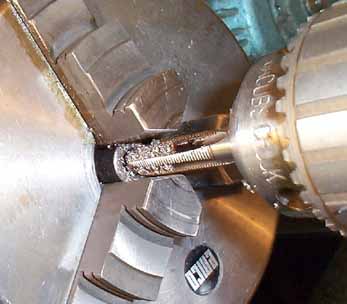
Chuck the stripped barrel assembly up in a hollow shaft lathe that is short enough to take it without removing the receiver. If you don’t have access to one, it’s time to visit a gunsmith or machinist. Either way, start out by setting the lathe at about 1250 rpm, center drill into the bore .75” with a letter “Q” (.332”) drill. Reset the lathe to your slowest speed and run a 3/8” x 24 NF starting tap in about .5”, back it out, and then follow this with a bottoming tap of the same size no deeper than .7”. By using this process the threads will not affect the accuracy of the gun when using live ammunition. In some cases it can actually improve accuracy as you are basically re-crowning the barrel. Make sure to clean the metal shavings and cutting fluid out of the barrel and chamber.
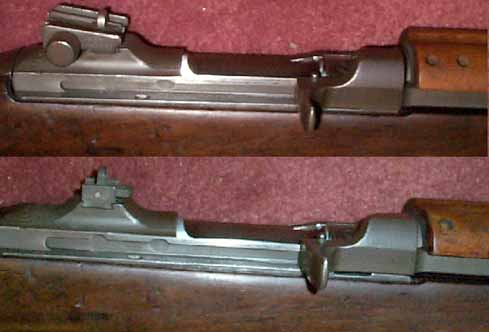
Now is a good time to install that “L” style rear sight, clamp the receiver into a smooth jaw vice (you may have to use a shim or two for a solid grip) and tap the sight off with a brass punch. You will probably have to do quite a bit of filing on the dovetail angles of the sight to get it to fit. Once you have a good tight fit, position the sight so that the long part of the “L” is towards the barrel when folded down, and then tap the sight on and back to dead center using a non-marring punch.
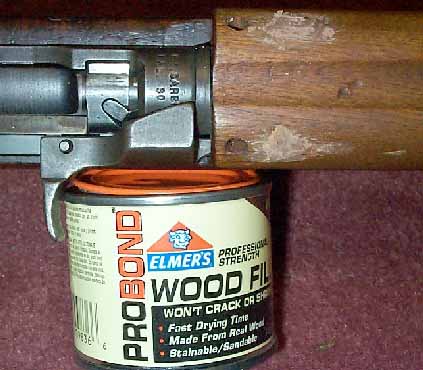
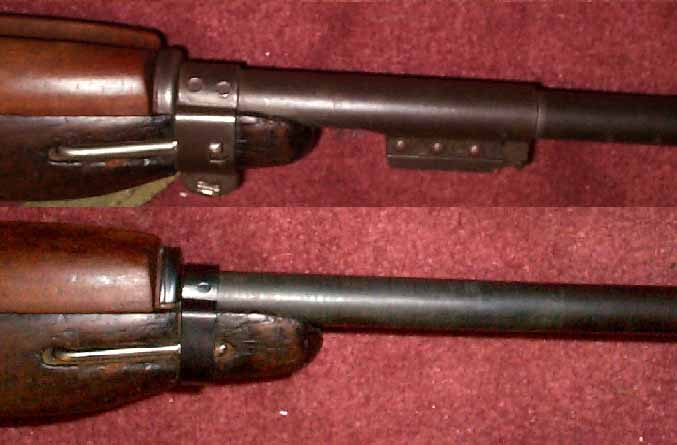
You can now begin to reassemble the gun, make sure the new barrel band mates properly with your stock and hand-guard before you put the front sight back on as it may require minor fitting. If you are not going to invest in an early style stock and two rivet hand-guard, you can at least fill in the front two hand-guard rivets with wood putty, sand it smooth and re-stain, for that war-time “look”. I usually leave the lever safety alone, but I understand that they can be replaced with a push button style, if you can find them.
Joe Swanson gives the restrictor hole size range for proper operation of the M1 Carbine with his blanks as .175” to .165” in diameter. When blank adapting any self-loading weapon you ALWAYS START WITH THE LARGEST HOLE DIAMETER FIRST.
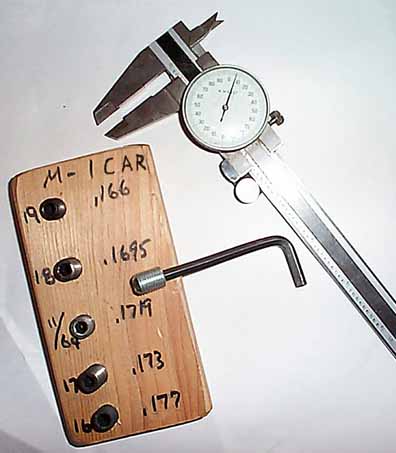
To make the blank adapter plugs for testing you have to drill out five 3/8” x 24 NF Allen socket set screws .5” in length. The black ones are case hardened and need to be “softened up” by heating them cherry red and letting them cool very slowly. The more common silver colored set screws are usually pretty soft with only the tips hardened, the tips can be ground off prior to drilling if you are careful and don’t screw up the threads.
These fractional and numerical drills (numerical drills are backwards, the smaller the number the larger the hole) are needed for the correct range of plugs: #16 (.177”), #17 (.173”), 11/64th (.1719”), #18 (.1695”), and #19 (.166”). When a lathe is used to drill out the set screws, a simple holding jig of round steel stock drilled and tapped to the proper thread size is helpful. A drill press may also be utilized for this process if a method of holding the set screws without damaging the threads can be devised.
Now comes the fun part. Thread the set screw with the LARGEST hole (#16) into the barrel of the carbine and test fire a blank round (eye and ear protection recommended), starting with a full magazine. If it ejects and chambers the next round you’re done. If not, unload the gun and change to the plug with the next smallest hole (#17), repeat this step down process with a full mag every time until you get reliable feeding of the first two rounds. It is a good idea to check the hole diameter of the new plug each time with a good dial caliper as it is impossible to see the small changes in size with the naked eye. Once you get it working you should be able to run a whole mag through without any stoppages. If you find that you always have trouble with the last few blanks in the mag this is usually an indication of a weak mag spring.
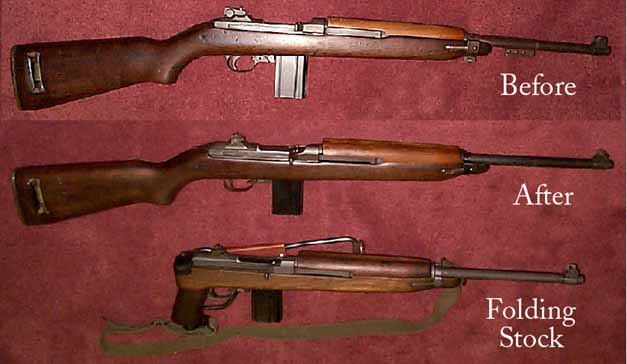
There you have it. Now you have a blank firing weapon suitable for a wide range of reenacting impressions, from G.I. to French Resistance, Partisan Warfare and even late war German! Oh, and if you want to do that U.S. Airborne thing, reproduction M1A1 folding stocks are available from Navy Arms or Sarco for about a hundred bucks.
Sources:
ARDENNES 1944 PEIPER & SKORZENY by Jean-Pallud, David Parker and Ron Volstad
GUNS of the REICH, Firearms of the German Forces, 1939-1945 by George Mantham
THE RESISTANCE, WORLD WAR II, TIME LIFE BOOKS by Russell Miller
THE ILLUSTRATED BOOK OF WORLD WAR II by Charles Messenger
U.S. ARMY PHOTO ALBUM, SHOOTING THE WAR IN COLOR 1941-1945 USA TO ETO by Jonathan Gawne
U.S. INFANTRY WEAPONS OF WORLD WAR II by Bruce N. Canfield
WEAPONS OF THE WAFFEN SS From small arms to tanks by Bruce Quarrie
WORLD WAR II SMALL ARMS by John Weeks
Vendors:
Navy Arms, phone: 800-669-NAVY, website: www.navyarmsmsd.com
Nunmrich Gun Parts, phone: 845-679-2417, website: e-GunParts.com
Sarco, phone: 908-647-3800, website: www.sarcoinc.com
Swanson Motion Picture Blanks, phone: 520-757-5851, website: www.ctaz.com/~joemar/